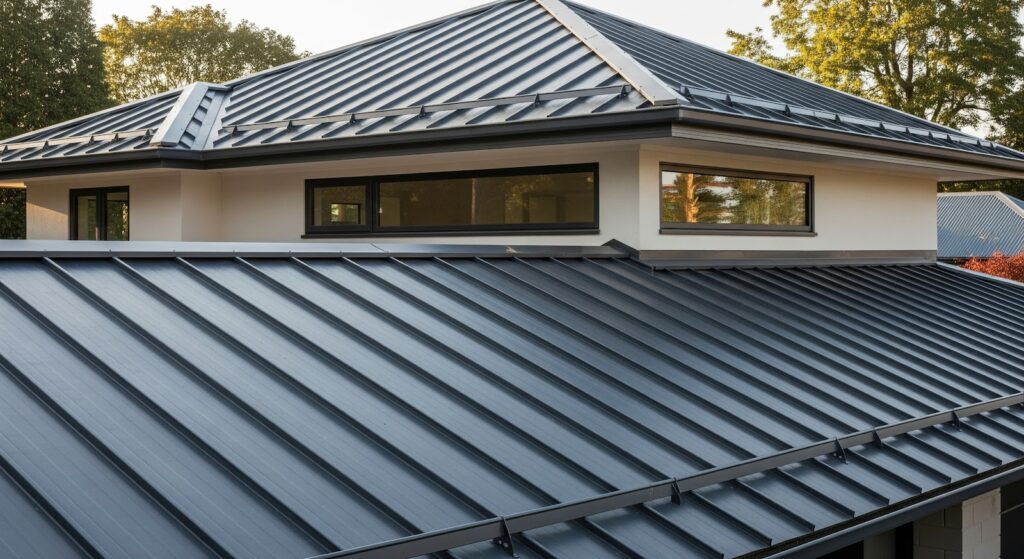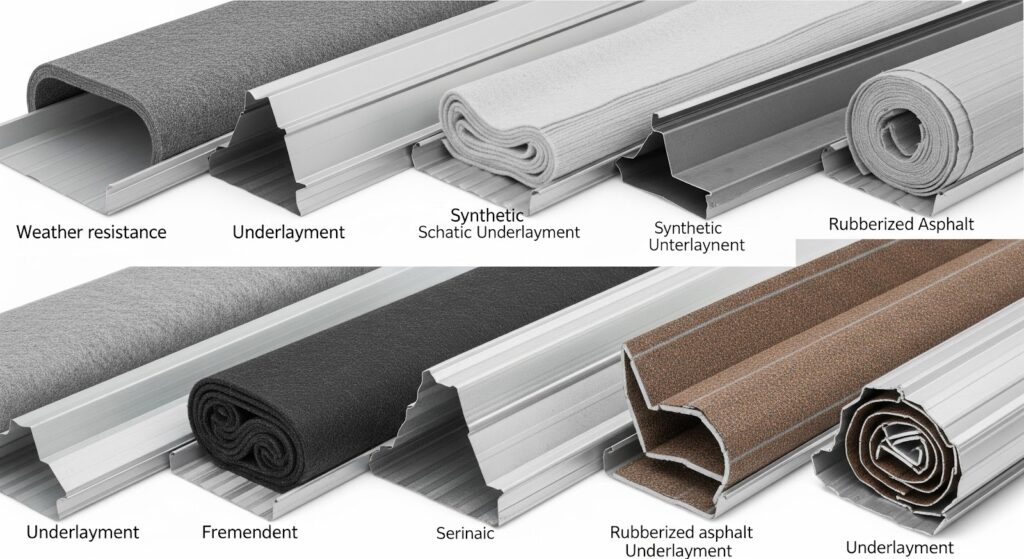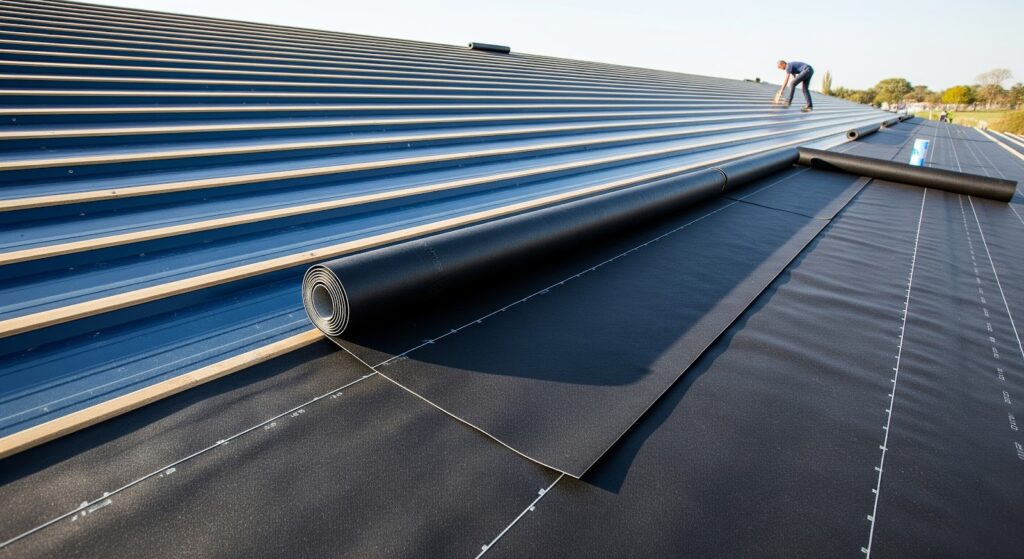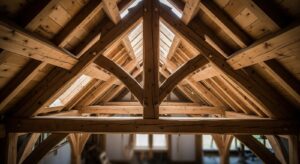When installing a steel roof, one of the most crucial decisions you’ll make is choosing the right underlayment. The best underlayment for steel roofing not only improves the longevity of your roof but also protects your home from moisture, ice, and extreme weather conditions. Without the right underlayment, even the best metal roofing panels can be susceptible to leaks, corrosion, and damage over time.
In this guide, we’ll explore the different types of underlayment available for steel and metal roofing systems, helping you determine the best option for your specific needs. Whether you’re considering synthetic underlayment, felt paper, or an ice and water shield, we’ve got you covered.
Why Is Underlayment Important for Steel Roofing?
Underlayment for steel roofing serves as a critical barrier between the roof deck and the roofing material. It provides protection from weather elements, such as rain, snow, and ice, that could otherwise penetrate the roof and cause damage. Even though metal roofs are highly durable and resistant to most environmental factors, the underlayment acts as an additional layer of defense, ensuring your roof stays waterproof and performs at its best for decades.
Key Functions of Roof Underlayment:
- Water Resistance: Helps prevent leaks and water infiltration.
- Ice Protection: Protects the roof against ice dams that can cause significant damage.
- Added Insulation: Some underlayment offer extra thermal insulation, helping to regulate the temperature inside your home.
- Corrosion Prevention: Certain underpayments act as a moisture barrier, reducing the risk of rust on your metal roof.
Now that you know why underlayment is essential, let’s look at the best underlayment for steel roofing options available.
What Goes Under Metal Roofing?

Before you choose the best underlayment for steel roofing, it’s important to understand what goes under a metal roof. In addition to the underlayment, the roofing system consists of several layers:
- Roof Deck: The base layer that provides structural support for your roofing system.
- Underlayment: The protective barrier placed directly on the roof deck.
- Metal Roof Panels: The final protective layer that shields the home from the elements.
The underlayment serves as a moisture-resistant barrier that helps protect the roof deck from rain, ice, and wind, ensuring that your metal roofing remains in great condition for years.
Types of Underlayment for Metal Roofing

When searching for the best underlayment for steel roofing, it’s essential to understand the various types available. Let’s explore the most common underlayment’s used under metal roofs:
1. Felt Underlayment for Metal Roof
Felt paper has been the traditional choice for roofing underlayment’s for decades. It’s made from organic materials (like wood fibers) or fiberglass, and it’s coated with asphalt to create a water-resistant layer.
- Pros: Cost-effective, widely available.
- Cons: Less durable than synthetic options, especially in areas with extreme weather.
- Best For: Felt paper under metal roof is ideal for mild climates and low-budget projects.
2. Synthetic Underlayment for Metal Roof
Synthetic underlayment is made from polymers and other synthetic materials, providing greater durability and resistance to water and UV rays compared to felt.
- Pros: More durable, lightweight, UV-resistant, and provides better moisture protection.
- Cons: Slightly higher cost than felt paper.
- Best For: Those seeking long-lasting protection in areas with heavy rainfall or snow.
Best Synthetic Underlayment for Metal Roof: Many professionals recommend synthetic underlayment from brands like GAF or CertainTeed due to their excellent performance in extreme weather conditions.
3. Ice and Water Shield
An ice and water shield underlayment is a self-adhesive membrane that is often used in areas prone to heavy snowfall or ice dams. It provides exceptional protection against water infiltration and is highly effective in preventing leaks caused by ice buildup.
- Pros: Superior moisture barrier, ideal for preventing ice dams.
- Cons: Higher cost than traditional underlayment options.
- Best For: Homes in colder climates that experience ice buildup or heavy rainfall.
4. Tar Paper Under Metal Roof
Tar paper is essentially a type of felt paper under metal roof with a higher asphalt content. It’s been used for centuries and still remains a popular choice for roofing systems in various applications.
- Pros: Economical and easy to install.
- Cons: Not as durable or long-lasting as synthetic options.
- Best For: Budget-friendly projects or for homes in moderate climates.
Best Ice and Water Shield Under Metal Roof
If you live in an area that experiences freezing temperatures, snow, or ice buildup, using an ice and water shield underlayment is highly recommended. It not only provides a strong water barrier but also adheres directly to the roof deck, preventing water from seeping through seams or joints.
Why Choose Ice and Water Shield for Metal Roof?
- Protection from Ice Dams: Prevents water from backing up underneath the roofing materials, which can cause leaks and water damage.
- Superior Waterproofing: Acts as an additional waterproof membrane, especially in areas where rain and snow are common.
Long-Term Durability: Typically lasts longer than traditional felt underlayment and provides a higher level of protection.
Best Underlayment for Standing Seam Metal Roof
For those considering a standing seam metal roof, it’s essential to choose the right underlayment. Standing seam roofs are highly durable and typically use concealed fasteners, making them less prone to leaks.
What Is the Best Underlayment for Standing Seam Metal Roof?
- Synthetic Underlayment: A synthetic underlayment for metal roof is ideal for standing seam metal roofs, as it provides superior strength, resistance to UV damage, and better moisture control. It’s lightweight and easy to install, making it a top choice for contractors.
- Ice and Water Shield: If you live in a cold climate or have areas prone to heavy snowfall, an ice and water shield under metal roof provides additional protection and peace of mind.
Does Metal Roofing Need Underlayment?
Many homeowners wonder if metal roofing requires underlayment at all. While some roofing systems may function without underlayment, it is always recommended for the following reasons:
- Extra Protection: Even the best metal roofing panels can be prone to water damage and ice buildup if they are not properly sealed. Underlayment adds an extra layer of defense.
- Enhanced Insulation: Some underlayment options provide thermal resistance, which helps regulate indoor temperatures.
- Moisture Barrier: The best moisture barrier for metal roof ensures water doesn’t seep through, causing damage to the roof deck.
What Goes Under Metal Roofing?
- Underlayment: This is an essential layer that goes under your metal roofing panels to prevent water infiltration and increase the roof’s overall lifespan.
Where to Buy the Best Underlayment for Steel Roofing
When you’re ready to purchase the best underlayment for steel roofing, it’s essential to know where to find quality products at competitive prices. Here are a few places to start:
1. Local Roofing Suppliers
Roofing suppliers near you typically offer a range of underlayment for metal roof options, from felt paper to synthetic underlayment and ice and water shields.
2. Big Box Retailers
Stores like Home Depot, Lowe’s, and Menards are great places to purchase roofing materials, including tar paper under metal roof, synthetic underlayment, and metal roof membrane.
3. Online Stores
Websites such as Amazon, Roofing Direct, or specialized roofing suppliers provide easy access to a variety of metal roof underlayment options, often with detailed product descriptions, user reviews, and delivery services.







